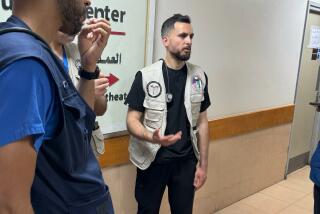U.S. Team Allowed to Treat Quake Victims : Aid: After frustrating delays, volunteers are permitted to run clinics for those left homeless in Kobe.
- Share via
KOBE, Japan — Health officials managing the medical relief effort have decided to let doctors be doctors, giving a team of 18 Southland doctors and nurses the tools and opportunity for the first time since the earthquake to practice medicine as they see fit.
In a breakthrough after half a week of frustration, Kobe officials allowed several members of a team of U.S. trauma specialists to spend the past two days running their own clinics to treat some of the 310,000 people left homeless by the massive Jan. 17 temblor.
“I really apologize to the foreign doctors for the rude way they were treated,” said Dr. Masanori Okazaki, 33, a neurology resident in Hiroshima who is providing treatment in Kobe.
The doctors had gained a solid understanding of refugees’ medical needs during two days spent backing up Japanese physicians at tent cities and refugee centers.
The difference now is that the Americans--organized into squads of one doctor and two nurses--can now fly solo at some of them.
A corner of Kitano Elementary School, for instance, became Kathy’s Clinic. Kathy Alfe, an obstetrics nurse at Northridge Hospital, set up a two-chair operation there on a day that the Japanese Red Cross had broken its promise to see patients there.
She dispensed a lot of sedatives, cough syrup and a hypertension drug to people who had lost their homes--and medicine cabinets--in the earthquake.
As the Americans’ education in earthquake epidemiology has grown, so has their understanding of Japan’s medical culture and the social organization of Kobe.
Each ward of the city has at least one elementary or high school, housing entire quake-flattened neighborhoods, that have been transformed into blanket-carpeted hallways and classrooms. Many wards also have slapdash, bitterly cold tent cities that house people who either fear flu outbreaks at the schools or feel excluded from them because they are Korean, Vietnamese or South Asian immigrants.
The American medical teams walk up to 15 miles against an icy wind each day to make painstaking rounds at these sites, largely eschewing taxis because hundreds of street closures had caused a maddening gridlock.
By the end of the week, however, so many Japanese doctors had arrived in drug-stuffed vans to assist in Kobe’s care that the Americans’ efforts were often in vain.
On Thursday, a team from Harbor-UCLA Medical Center that included Los Angeles County trauma care expert Dr. Stanley Klein and the hospital’s trauma coordinator, Debra Gilmore, walked for hours in fire-devastated Nagata-ku neighborhoods and only found three or four patients to treat.
Still, they felt like they had done some good by sorting through the hundreds of people who just needed Tylenol to find ones who reluctantly confessed that they were truly hurting.
With the buzz of building-clearing bulldozers replacing the screech of ambulance sirens, the American relief team planned to return home Saturday.
“You know that you’re not doing anything terribly unique,” said Johnny Harrison, a UCLA Medical Center anesthesiologist, “but in the small-scale human drama of day-to-day life, we let these people know that Americans cared about them.”
More to Read
Sign up for Essential California
The most important California stories and recommendations in your inbox every morning.
You may occasionally receive promotional content from the Los Angeles Times.













